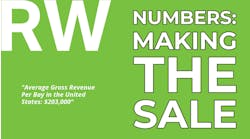It’s the question many small business owners will inevitably ask when it comes to social media: How do you track return on investment?
The reality? It might not be possible, Olivia Hensley says. But in the 21st century, it’s crucial for branding your shop.
“Chances are we’re not going to see a very huge dollar-for-dollar ROI. The time and energy might not produce that,” says Hensley, founder for the marketing consultant company, Smart Marketing Biz. “What we can do, however, is achieve top-of-mind awareness online, and your effectiveness on social media will determine that.”
And to make sure your posts are reaching the right people, you’ll need to make sure you’re on the proper social media platforms. Hensley and her company’s social media manager, Becky Morris, and Jenna Gross, CMO of Moving Targets, discuss the platforms that can increase your social media presence and whether those platforms are right for your shop.
Research Your Audience
Knowing your customer demographics will guide many of your social media marketing plan components, Morris says.
“You have to put yourself in your customers’ shoes,” she says. “Are they going to engage with your activity?”
Having zero social media presence is not an option, Morris says. Overall, social media use has gone up with every age group since 2005, reports the Pew Research Center. As of 2015, 76 percent of Internet users are on social media, which includes 77 percent of people in the 30–49 age range, 51 percent for ages 50–64, and 35 percent for 65 and up.
So while being active on social media is a must, the importance of using multiple platforms will vary.
- Facebook is used across the board and dominated by age groups that range from 25 to 54, according to analytics firm comScore; that group accounts for over 75 percent of all Facebook users.
- Google+, YouTube and Twitter are also heavily used by the 25–54 age range, as that group makes up for 65 percent, 63 percent and 61 percent of users for each respective platform.
- While 23 percent of Instagram users fall into the 18–24 age range, there is healthy activity among ages 25–54 at 60 percent.
- Contrary to popular belief, Hensley says, the 18–24 age range makes up only 15 percent of Pinterest users.
- The only platforms dominated by the 18–24 age range are Vine, Tumblr and Snapchat.
Form a Campaign Calendar
After choosing which platforms you’ll use, Morris says to craft a “campaign calendar” that plans out posts and ideas for the next week, month and even year. Create a document that outlines how often you’ll utilize each account, and different topics you can post or re-post about throughout the year.
“If you want to make a post for National Cookie Day on Facebook, you can schedule that six months in advance and be done with it,” Morris says.
Establish a Blog
An easy way to ensure you always have content to post is to establish a blog on your website, where you can highlight repairs in your shop and auto care tips. Visit ratchetandwrench.com/blog.
How you approach each platform will depend entirely on how it falls into two categories, Gross says: Is the platform better designed for business promotion or social activity? A business platform is meant to generate web traffic and revenue, while a social platform focuses on engagement and being interactive—and both are meant to drive traffic into your shop.
Believe it or not, Facebook, the king of social media, is considered a business platform, Gross says, and that’s only becoming more apparent with time, as Facebook advertising becomes more prevalent and competitive, seeing 50 percent growth in 2015–2016.
Facebook gets the most engagement of any platform, and of the 25-plus industries Moving Targets represents, auto care ranks near the top when it comes to engagement, she says.
Your Facebook page is where you’ll control your business’s brand online. It’s all about top-of-mind awareness, Morris says, and everything you post has the intention of establishing your shop’s expertise, by highlighting jobs around the shop and car care tips.
For Facebook, Morris says to be active daily. Post at optimal hours, which is when people get to work, take their lunch and leave work. You can schedule posts in advance, using the drop-down menu located next to “Publish.” Look to publish blog posts from your website, five-star reviews from Yelp and Google, your staff’s philanthropy, employee birthdays, etc.
Google+
With Google dominating online searches, Google+ is one of the most crucial business accounts to have, Hensley says. Your activity and information available on Google+ will greatly influence traffic to your website.
As opposed to something like Twitter, Hensley says, you aren’t trying to create conversations on Google+—you’re making blog posts, showing you’re the expert. Make sure any SEO-boosting keywords that highlight your shop’s specialties (whether it be brakes, transmissions, tires or European makes) are included in these posts.
Google+ can be used weekly, highlighting blog posts from your website. Morris suggests arranging your calendar to mix new posts and old stories from your blog
YouTube
Your Google+ account will double as your YouTube account, which is also a business account and can contribute just as much to your SEO as Google+.
Much like how you populate your Facebook and Google+ page, Gross recommends putting out short videos (about 20–30 seconds) that show your shop performing various jobs, highlight members of your team, provide customer testimonials, etc. Populate those videos with between 5–10 keywords that consist of your town, your specialties and anything related to automotive repair, which will all help in ranking high on Google.
YouTube requires more time, money and planning, so keep video posts monthly—if that. You videos can mimic the material of your blog posts, meaning you could write and shoot simultaneously.
Time and time again, Gross witnesses businesses misusing Twitter—it’s a social platform, not a business one.
“People will just repost material from Facebook to Twitter,” she says. “Twitter is a chance for you to interact with your audience.”
While you can certainly post about your business on Twitter, it’s a platform designed for discussion, so take the time to engage with users, Gross says. Search common auto repair phrases and questions and offer advice and solutions. While you may not always be interacting with a potential customer, they could certainly see your posts if they search the topic.
Also, tag area businesses in posts and retweet posts you think potential customers in your region could or should see.
Twitter should be used weekly. Budget the time in your calendar to check searches throughout the week, and plan out a steady stream of general car tips.
Instagram & Pinterest
Instagram and Pinterest are also great social platforms, Gross says, that can drive traffic directly to your website. Auto repair shops are blessed with a plethora of cars to choose from, so take advantage to highlight various makes, unique repairs and anything else that paints the personality of your shop.
Also keep in mind your hashtag use, which aids search results. Keep them focused on auto repair and your shop, and use no more than 10 hashtags.
Gross says there isn’t any science to the timing of Instagram and Pinterest posts, which are done on-the-fly. Just post photos of interesting work when you can. Be sure to keep active weekly, though.
Snapchat, Vine & Tumblr
Popular among the 18–24 crowd, Snapchat, Vine and Tumblr represent a unique opportunity to reach that younger demographic.
Gross doesn’t recommend using them unless you receive heavy traffic from that crowd. But if you do, you’ll be able to separate yourself from the competition. Just keep it active, fun and light with videos and photos.



